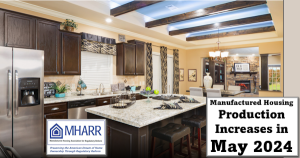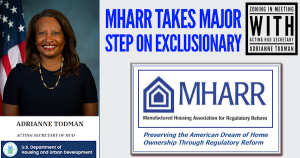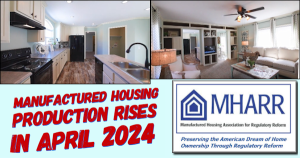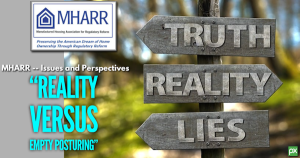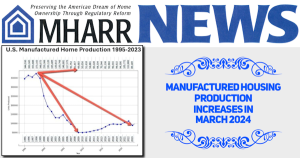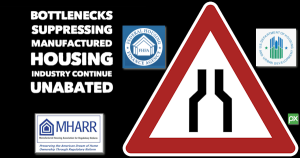Drastic 2023 Manufactured Housing Production Decline Warrants Much Stronger Action
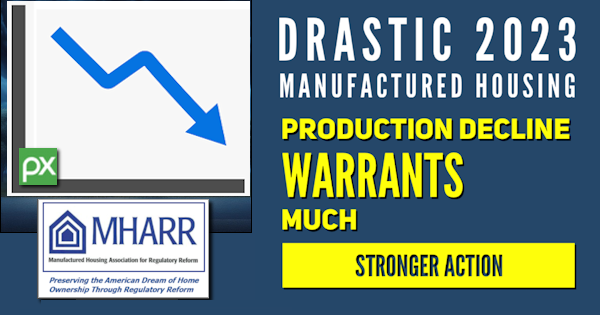
DRASTIC 2023 PRODUCTION DECLINE WARRANTS MUCH STRONGER ACTION
Washington, D.C., February 5, 2024 – The Manufactured Housing Association for Regulatory Reform (MHARR) reports that according to official statistics compiled on behalf of the U.S. Department of Housing and Urban Development (HUD), HUD Code manufactured housing industry year-over-year production declined again in December 2023. Just-released statistics indicate that HUD Code manufacturers produced 6,360 new homes in December 2023, a .7% decrease from the 6,406 new HUD Code homes produced in December 2022. Cumulative production for 2023 thus totals 89,169 homes, a 21% decrease from the 112,882 HUD Code homes produced during 2022.
A further analysis of the official industry statistics shows that the top ten shipment states from January 2023 — with monthly, cumulative, current reporting year (2023) and prior year (2022) shipments per category as indicated — are:
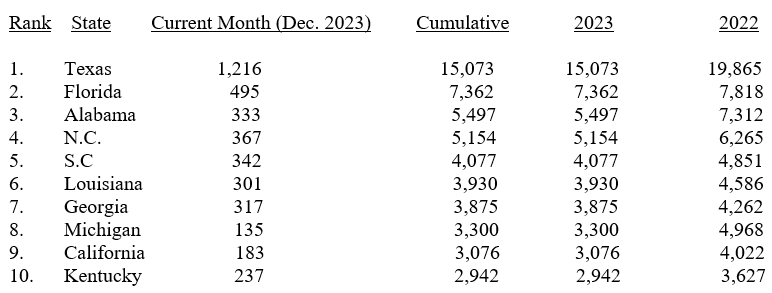
The December 2023 statistics result in no changes to the top-ten shipment state list.
The final 2023 production statistics reflect a continuing sharp decline in manufactured housing production and shipments that began during the final quarter of 2022 and has continued ever since. This major decline, which would only be deepened and intensified by implementation of the draconian – and unnecessary — U.S. Department of Energy (DOE) May 31, 2022 “energy conservation” standards for HUD Code manufactured homes, represents an ongoing catastrophe for lower and moderate-income American families in need of inherently affordable housing and homeownership. This is especially the case in an environment where the cost of (non-HUD Code) homeownership has ballooned to historically high levels and the need for housing affordability of the sort provided by HUD Code homes has never been greater.
Aside from the impending DOE energy standards, which would only further undermine the industry and its ability to meet the nation’s dire need for affordable housing and homeownership, the sad reality is that the solution to most of the current production decline is actually quite straightforward. Put simply, the industry’s national post-production representation has failed, for far too long, to effectively and aggressively address and resolve the two main bottlenecks that have suppressed industry production and the availability of affordable manufactured housing – i.e., exclusionary zoning and the availability of competitive consumer financing, particularly within the industry’s dominant chattel lending sector. While the industry and its consumers have two good laws to correct these needless roadblocks – i.e., the enhanced preemption of the Manufactured Housing Improvement Act of 2000 and the Duty to Serve provision of the Housing and Economic Recovery Act of 2008 — the industry’s national post-production representation in Washington, D.C. has been unable to compel the full and proper implementation of these two laws. Accordingly, much stronger action by that representation is essential, while current and ongoing failures should be unacceptable to both the industry and consumers.
If the industry is to achieve any improvement in 2024 and beyond, all of these issues will need to be aggressively and effectively addressed, without apology, through strong defense, protection and advancement of the industry’s most affordable mainstream homes (rather than higher-priced substitutes) and strong advocacy on behalf of consumers and the industry. More meetings, conferences and seminars will not resolve these major bottlenecks. Much stronger action is long overdue.
The Manufactured Housing Association for Regulatory Reform is a Washington, D.C.- based national trade association representing the views and interests of independent producers of federally-regulated manufactured housing.
DRASTIC 2023 PRODUCTION DECLINE WARRANTS MUCH STRONGER ACTION
Washington, D.C., February 5, 2024 – The Manufactured Housing Association for Regulatory Reform (MHARR) reports that according to official statistics compiled on behalf of the U.S. Department of Housing and Urban Development (HUD), HUD Code manufactured housing industry year-over-year production declined again in December 2023. Just-released statistics indicate that HUD Code manufacturers produced 6,360 new homes in December 2023, a .7% decrease from the 6,406 new HUD Code homes produced in December 2022. Cumulative production for 2023 thus totals 89,169 homes, a 21% decrease from the 112,882 HUD Code homes produced during 2022.
A further analysis of the official industry statistics shows that the top ten shipment states from January 2023 — with monthly, cumulative, current reporting year (2023) and prior year (2022) shipments per category as indicated — are:

The December 2023 statistics result in no changes to the top-ten shipment state list.
The final 2023 production statistics reflect a continuing sharp decline in manufactured housing production and shipments that began during the final quarter of 2022 and has continued ever since. This major decline, which would only be deepened and intensified by implementation of the draconian – and unnecessary — U.S. Department of Energy (DOE) May 31, 2022 “energy conservation” standards for HUD Code manufactured homes, represents an ongoing catastrophe for lower and moderate-income American families in need of inherently affordable housing and homeownership. This is especially the case in an environment where the cost of (non-HUD Code) homeownership has ballooned to historically high levels and the need for housing affordability of the sort provided by HUD Code homes has never been greater.
Aside from the impending DOE energy standards, which would only further undermine the industry and its ability to meet the nation’s dire need for affordable housing and homeownership, the sad reality is that the solution to most of the current production decline is actually quite straightforward. Put simply, the industry’s national post-production representation has failed, for far too long, to effectively and aggressively address and resolve the two main bottlenecks that have suppressed industry production and the availability of affordable manufactured housing – i.e., exclusionary zoning and the availability of competitive consumer financing, particularly within the industry’s dominant chattel lending sector. While the industry and its consumers have two good laws to correct these needless roadblocks – i.e., the enhanced preemption of the Manufactured Housing Improvement Act of 2000 and the Duty to Serve provision of the Housing and Economic Recovery Act of 2008 — the industry’s national post-production representation in Washington, D.C. has been unable to compel the full and proper implementation of these two laws. Accordingly, much stronger action by that representation is essential, while current and ongoing failures should be unacceptable to both the industry and consumers.
If the industry is to achieve any improvement in 2024 and beyond, all of these issues will need to be aggressively and effectively addressed, without apology, through strong defense, protection and advancement of the industry’s most affordable mainstream homes (rather than higher-priced substitutes) and strong advocacy on behalf of consumers and the industry. More meetings, conferences and seminars will not resolve these major bottlenecks. Much stronger action is long overdue.
The Manufactured Housing Association for Regulatory Reform is a Washington, D.C.- based national trade association representing the views and interests of independent producers of federally-regulated manufactured housing.


